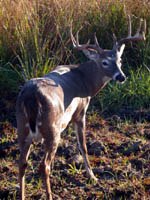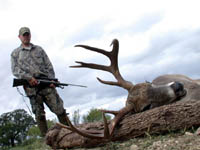
|
Features
|
|
|
|
Books
|
|
|
|
Fun & Games
|
|
|
|
Contact Us
|
|
|
John's Journal... Entry 223, Day 3
THE FEAR FACTOR: HOW MUCH HUNTING PRESSURE CAN A BUCK STAND?
Amount Of Human Contact A Buck Can Stand Before Reducing Movement And Nocturnal Deer
 Many
hunters believe the more a deer sees or smells humans, the less likely
that animal is to appear in the woods during daylight hours. However,
Bob Foulkrod believes the intent of the human determines the fear factor
of the buck. “If a buck is in a non-pressure situation where he
sees hikers, blueberry pickers or photographers during the summer months,
he may run on first sighting the human before turning to see if he’s
being pursued,” Foulkrod mentioned. “When he realizes he isn’t
being chased or shot at, he can take a lot of human pressure. But after
hunting season opens, and the bucks realize that every time they come
in contact with humans, they will be pursued, only a little pressure will
put a buck into his nocturnal state. He will cease his daytime activities
– especially if he is a 2-1/2 or 3-1/2-year old deer.” Dr.
Keith Causey agrees with Foulkrod as he states that, “Since deer
are individuals, determining how much hunting pressure one deer can withstand
and using that information to draw a conclusion about all deer is impossible.
However, from the harvest data I’ve seen and the data I’ve
looked at, I know that when a buck is 3-years old or older and experiences
intense hunting pressure then he becomes reclusive in his behavior and
almost impossible to harvest legally because of his nocturnal activity.”
Many
hunters believe the more a deer sees or smells humans, the less likely
that animal is to appear in the woods during daylight hours. However,
Bob Foulkrod believes the intent of the human determines the fear factor
of the buck. “If a buck is in a non-pressure situation where he
sees hikers, blueberry pickers or photographers during the summer months,
he may run on first sighting the human before turning to see if he’s
being pursued,” Foulkrod mentioned. “When he realizes he isn’t
being chased or shot at, he can take a lot of human pressure. But after
hunting season opens, and the bucks realize that every time they come
in contact with humans, they will be pursued, only a little pressure will
put a buck into his nocturnal state. He will cease his daytime activities
– especially if he is a 2-1/2 or 3-1/2-year old deer.” Dr.
Keith Causey agrees with Foulkrod as he states that, “Since deer
are individuals, determining how much hunting pressure one deer can withstand
and using that information to draw a conclusion about all deer is impossible.
However, from the harvest data I’ve seen and the data I’ve
looked at, I know that when a buck is 3-years old or older and experiences
intense hunting pressure then he becomes reclusive in his behavior and
almost impossible to harvest legally because of his nocturnal activity.”
 What
Actually Happens When A Deer Becomes Nocturnal?
What
Actually Happens When A Deer Becomes Nocturnal?
Brad Harris is convinced there are trophy bucks on many public-hunting areas throughout the nation. However, he also believes these bucks have learned to use the cover of darkness to hide their movements. “The older-age-class bucks with several years of hunting experience know intimately the area of the woods they’ve lived in for many years as well as when and where hunters will appear during daylight hours,” Harris commented. “These bucks have learned more about how to pattern hunters and their movements than the hunters understand about how to pattern deer. These trophy bucks do not move in regions where hunters are during daylight hours. They’re not lying down all day long but are moving in places where hunters are not.” Dr. Sheppard agrees with Harris about Harris’ observations and offers an interesting way to find and take these nocturnal bucks. “At night when deer move through the woods, they can smell where the hunter has been all day long,” Sheppard reported. “Then the older-class bucks avoid those places during daytime hours by moving into thick cover where no human voluntarily will walk. One of the regions where an older-age-class, nocturnal buck likes to stay during daytime hours is in a five or a six year old clear-cut. You can bag these nocturnal bucks by climbing as high as you can in a tree stand, which allows you to look down into a clear-cut. I’ve seen older-age-class bucks in these heavy-cover clear-cuts stand up, stretch, urinate and defecate. They may walk one or two yards before lying down again. By using a pair of binoculars, I’ve been able to spot these bucks when they stand up or move their heads from side to side. These thick-cover, nocturnal bucks only may move 30 yards in a 15-hour day. But, if you’re high enough to look down into a ticket, oftentimes you can take these trophy bucks, even though they are nocturnal.”
TOMORROW: WHAT HUNTERS CAN DO TO REDUCE PRESSURE AND INCREASE DEER SIGHTINGS AND HUNTING THESE PRESSURED BUCKS
Check back each day this week for more about THE FEAR FACTOR: HOW MUCH HUNTING PRESSURE CAN A BUCK STAND?...
Day 1 - Fear of Dogs Moves
Deer
Day 2 - How Deer Learn To Fear Man
Day 3 - Amount Of Human Contact A Buck Can
Stand Before Reducing Movement And Nocturnal Deer
Day 4 - What Hunters Can Do To Reduce Pressure
And Increase Deer Sightings And Hunting These Pressured Bucks
Day 5 - Prevent A Buck From Seeing, Smelling
or Hearing You, Thereby Decreasing Hunter Pressure